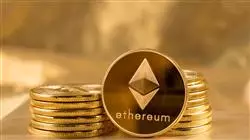University certificate
The world's largest faculty of information technology”
Introduction to the Program
You are just one step away from being part of the digital revolution that is transforming the entertainment industry forever. Join TECH now”

In traditional games, developers control the internal markets; however, with the Blockchain, transactions and ownership of assets are distributed among participants. As a result, a more open marketplace has resulted, without intermediaries, where players can exchange goods with each other. Moreover, thanks to these technologies, a more autonomous and fluid in-game economy has been created. This decentralization, on the other hand, opens new doors to the creation of dynamic markets, where prices and transactions do not depend on a central authority, but on the free market of the players.
Cryptocurrencies and tokens have driven economic opportunities in regions with limited access to traditional financial services. Players can participate in virtual economies without the need for bank accounts, facilitating financial inclusion and enabling revenue generation through video games. This has led to new forms of employment and global economic interaction. In addition, the interoperability that Blockchain and NFTs offer allows assets to be moved between games, creating a broader and more flexible ecosystem for players. However, managing this expanding sector requires expertise in both technology and its business application. For this reason, TECH has developed a comprehensive program that delves into the development of public blockchains and their application in the Gaming industry. This intensive, theoretical and practical course focuses on advanced tools to create secure and successful projects, combining Blockchain programming with crypto-gaming economics.
In this way, in just months of intensive learning, the students of this Advanced master’s degree will be able to update their knowledge through the most effective learning method in the university landscape: the Relearning. This approach adapts to the learning pace of each student, since the content is available 24 hours a day and is accessible from any device with an Internet connection.
This Advanced master’s degree is your ticket to turn your passion for video games into your dream, innovative and profitable career”
This Advanced master’s degree in Blockchain Economics and NFT in Video Games contains the most complete and up-to-date educational program on the market. Its most notable features are:
- The development of case studies presented by experts in Blockchain Economics and NFT in Video Games
- The graphic, schematic, and practical contents with which they are created, provide scientific and practical information on the disciplines that are essential for professional practice
- Practical exercises where self-assessment can be used to improve learning
- Its special emphasis on innovative methodologies in Blockchain Economics and NFT in Video Games
- Theoretical lessons, questions to the expert, debate forums on controversial topics, and individual reflection assignments
- Content that is accessible from any fixed or portable device with an Internet connection
Lead the virtual world learning with the most updated and enriching didactic methodology in the current academic panorama”
It includes in its teaching staff professionals belonging to the field of Blockchain Economics and NFT in Video Games, who pour into this program the experience of their work, in addition to recognized specialists from reference companies and prestigious universities.
The multimedia content, developed with the latest educational technology, will provide the professional with situated and contextual learning, i.e., a simulated environment that will provide an immersive learning experience designed to prepare for real-life situations.
This program is designed around Problem-Based Learning, whereby the student must try to solve the different professional practice situations that arise throughout the program. For this purpose, the professional will be assisted by an innovative interactive video system created by renowned and experienced experts.
Invest in yourself and build the best professional future with TECH, the world's largest online university"

Through a 100% online methodology you will begin to master the most important technological knowledge from anywhere in the world"
Why study at TECH?
TECH is the world’s largest online university. With an impressive catalog of more than 14,000 university programs available in 11 languages, it is positioned as a leader in employability, with a 99% job placement rate. In addition, it relies on an enormous faculty of more than 6,000 professors of the highest international renown.

Study at the world's largest online university and guarantee your professional success. The future starts at TECH”
The world’s best online university according to FORBES
The prestigious Forbes magazine, specialized in business and finance, has highlighted TECH as “the world's best online university” This is what they have recently stated in an article in their digital edition in which they echo the success story of this institution, “thanks to the academic offer it provides, the selection of its teaching staff, and an innovative learning method aimed at educating the professionals of the future”
A revolutionary study method, a cutting-edge faculty and a practical focus: the key to TECH's success.
The most complete study plans on the university scene
TECH offers the most complete study plans on the university scene, with syllabuses that cover fundamental concepts and, at the same time, the main scientific advances in their specific scientific areas. In addition, these programs are continuously being updated to guarantee students the academic vanguard and the most in-demand professional skills. In this way, the university's qualifications provide its graduates with a significant advantage to propel their careers to success.
TECH offers the most comprehensive and intensive study plans on the current university scene.
A world-class teaching staff
TECH's teaching staff is made up of more than 6,000 professors with the highest international recognition. Professors, researchers and top executives of multinational companies, including Isaiah Covington, performance coach of the Boston Celtics; Magda Romanska, principal investigator at Harvard MetaLAB; Ignacio Wistumba, chairman of the department of translational molecular pathology at MD Anderson Cancer Center; and D.W. Pine, creative director of TIME magazine, among others.
Internationally renowned experts, specialized in different branches of Health, Technology, Communication and Business, form part of the TECH faculty.
A unique learning method
TECH is the first university to use Relearning in all its programs. It is the best online learning methodology, accredited with international teaching quality certifications, provided by prestigious educational agencies. In addition, this disruptive educational model is complemented with the “Case Method”, thereby setting up a unique online teaching strategy. Innovative teaching resources are also implemented, including detailed videos, infographics and interactive summaries.
TECH combines Relearning and the Case Method in all its university programs to guarantee excellent theoretical and practical learning, studying whenever and wherever you want.
The world's largest online university
TECH is the world’s largest online university. We are the largest educational institution, with the best and widest online educational catalog, one hundred percent online and covering the vast majority of areas of knowledge. We offer a large selection of our own degrees and accredited online undergraduate and postgraduate degrees. In total, more than 14,000 university degrees, in eleven different languages, make us the largest educational largest in the world.
TECH has the world's most extensive catalog of academic and official programs, available in more than 11 languages.
Google Premier Partner
The American technology giant has awarded TECH the Google Google Premier Partner badge. This award, which is only available to 3% of the world's companies, highlights the efficient, flexible and tailored experience that this university provides to students. The recognition as a Google Premier Partner not only accredits the maximum rigor, performance and investment in TECH's digital infrastructures, but also places this university as one of the world's leading technology companies.
Google has positioned TECH in the top 3% of the world's most important technology companies by awarding it its Google Premier Partner badge.
The official online university of the NBA
TECH is the official online university of the NBA. Thanks to our agreement with the biggest league in basketball, we offer our students exclusive university programs, as well as a wide variety of educational resources focused on the business of the league and other areas of the sports industry. Each program is made up of a uniquely designed syllabus and features exceptional guest hosts: professionals with a distinguished sports background who will offer their expertise on the most relevant topics.
TECH has been selected by the NBA, the world's top basketball league, as its official online university.
The top-rated university by its students
Students have positioned TECH as the world's top-rated university on the main review websites, with a highest rating of 4.9 out of 5, obtained from more than 1,000 reviews. These results consolidate TECH as the benchmark university institution at an international level, reflecting the excellence and positive impact of its educational model.” reflecting the excellence and positive impact of its educational model.”
TECH is the world’s top-rated university by its students.
Leaders in employability
TECH has managed to become the leading university in employability. 99% of its students obtain jobs in the academic field they have studied, within one year of completing any of the university's programs. A similar number achieve immediate career enhancement. All this thanks to a study methodology that bases its effectiveness on the acquisition of practical skills, which are absolutely necessary for professional development.
99% of TECH graduates find a job within a year of completing their studies.
Advanced Master's Degree in Blockchain Economics and NFT in Video Games
The permanent development of technology and advances in computer systems has given rise for different sectors to undergo transformations. This is the case of video games, as the consolidation and integration of Blockchain and NFT models have revolutionized the environment of players in an experience that not only has recreational purposes, but also economic ones. Faced with an area of continuous growth and changing dynamics, the industry requires the specialized knowledge of IT professionals to manage the technology involved in blockchain, in addition to business application and DeFi services. For this reason, in TECH Global University we developed the Advanced Master's Degree in Blockchain Economics and NFT in Video Games, a program that collects in a complete way the update and deepening in this area of computer science. In this way, you will have at your disposal an academic path with innovative content, and the tools, techniques and strategies that will lead you to master the application of blockchain in the video game industry.
Specialize in Blockchain Economics and NFT in Video Games
At TECH Global University you will be able to reach a new level of knowledge to advance your professional goals. Hand in hand with innovative methodologies, the accompaniment of experts in the area and a specialized curriculum, you will identify the functioning of Blockchain technology, its main features, advantages and disadvantages in the framework of decentralized finance; you will identify the fundamental characteristics of non-fungible tokens; and you will understand the linkage of NFTs with blockchains from applicable strategies to generate and extract value with integration to the global economy and virtual gamification projects. This program is a unique opportunity to sharpen your technical skills and stand out effectively in a highly competitive industry. Becoming a graduate of the university with the largest Faculty of Computer Science in the world is the next step in achieving your career goals.







